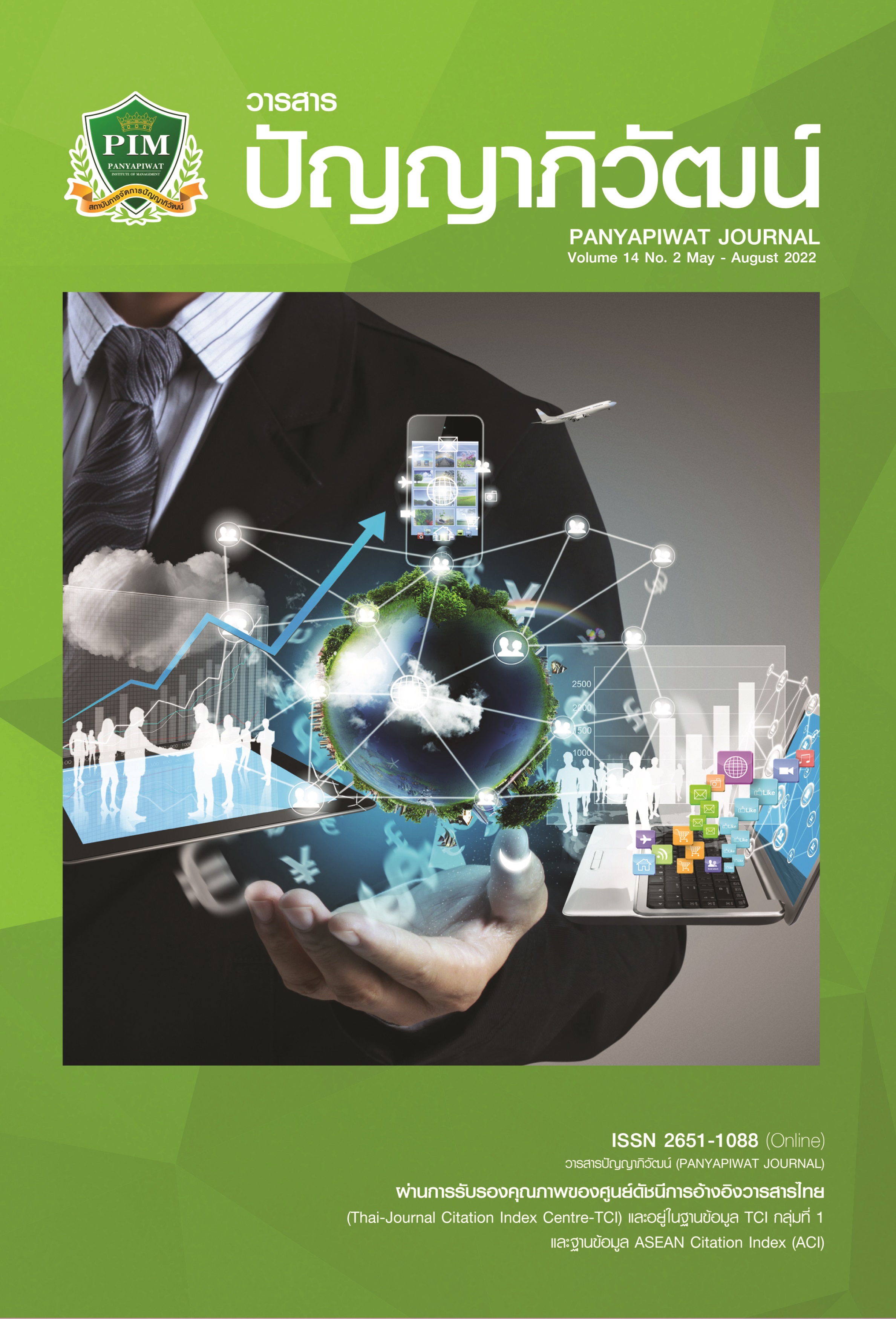THE CULTURAL PRODUCTS DEVELOPMENT UNDER THE CREATIVE ECONOMY CONCEPT IN CHIANG RAI OLD TOWN AREA, MUEANG DISTRICT, CHIANG RAI PROVINCE
Main Article Content
Abstract
This research has the following objectives: (1) to study and evaluate the value of cultural resources in Chiang Rai Old Town area in order to design and develop cultural products and (2) to develop the creative cultural products with the use of cultural capital in Chiang Rai Old Town area that indicates the identity of Chiang Rai Old Town area. This study is a qualitative research by exploring the cultural resources, in-depth interviews with a group of 13 cultural resource owners and design scholars. The data are analyzed together with the data from the documents to find the cultural capital and guidelines for the cultural products development that show the identity of Chiang Rai Old Town.
The research results are (1) there are three types of important local cultural resources in the old town area: in the study field of Humanities, there are 17 festivals; in the study field of Arts and Crafts, there are two types of arts and crafts, i.e. Chiang Rai city planning and the commercial buildings; in the study field of Home Economics, there is the Hakka food wisdom and (2) regarding the cultural products development that indicates the identity of Chiang Rai Old Town area, the Xi Piao commercial shop building has been selected to be the inspiration for the design of two products; (1) a packaging bag that is designed using color and the font style of letters that appear on the shop’s nameplate; and (2) a packaging box that is designed after the shape of the Xi Piao commercial shop building which is the first two-story wooden building in Chiang Rai Old Town area and it is among the few buildings that remain in Chiang Rai Old Town area today.
Article Details

This work is licensed under a Creative Commons Attribution-NonCommercial-NoDerivatives 4.0 International License.
I and co-author(s) certify that articles of this proposal had not yet been published and is not in the process of publication in journals or other published sources. I and co-author accept the rules of the manuscript consideration. Both agree that the editors have the right to consider and make recommendations to the appropriate source. With this rights offering articles that have been published to Panyapiwat Institute of Management. If there is a claim of copyright infringement on the part of the text or graphics that appear in the article. I and co-author(s) agree on sole responsibility.
References
Anupongsanukul, N. (2020, January 14). Interview by N. Namajaidee [Tape recording]. Hakka food Entrepreneur in Chiang Rai Old City. Chiang Rai Province. [in Thai]
Arvorn, C. (2019). Photographer of the Lampang Group, 1932-1961: Searching for new issues in art history. Damrong Academic Journal, 18(2), 33-60. [in Thai]
Chakmool, P. (2019, September 5). Interview by N. Namajaidee [Tape recording]. Sample Group Selling Cultural Products Chiang Rai Walking Street. Chiang Rai Province. [in Thai]
Cuber, J. F. (1968). Sociology: A synopsis of principles. Appleton-Century-Crofts. Donnet, T. (2019, September 16). Interview by N. Namajaidee [Tape recording]. Director of Religious Promotion Group Arts and culture. Chiang Rai Provincial Cultural Office.
[in Thai]
Food Intelligence Center Thailand. (2020). Sino-Portuguese packaging. http://fic.nfi.or.th/technologyandinnovation-detail.php?smid=6 [in Thai]
Hanphiphat, P. (2017, August 23). Interview by N. Namajaidee [Tape recording]. Owner of Baan Norn Plearn Hotel. Chiang Rai Province. [in Thai]
Jamjit, C. (2000). Chiang Rai City record. Chainarai. [in Thai]
Lertchanrit, T. (2011). Cultural resource management (2nd ed.). Sirindhorn Anthropology Center (Public Organization). [in Thai]
Lipe, W. D. (1984). Value and meaning in cultural resources approaches to the archaeological heritage. Cambridge University.
Muangkram, J. (2012). The study of western architecture in Chiang Rai under the roles of American Presbyterian missionaries [Master’s thesis]. Silpakorn University. [in Thai]
Namjaidee, N. (2020). Survey and study of important cultural resources in the district area Chiang Rai old town Mueang District Chiang Rai Province. Journal of Social Academic, 13(1), 37-47. [in Thai]
Onaree, N. (2017). The merger of cultural assets in packaging design of souvenirs from Japan. Journal of Information, 16(2), 31-40. [in Thai]
Phetsuriya, N. (2014). Preference study of Lampang old city shophouses’ façades. Journal Environment Design, 1(1), 1-14. [in Thai]
Praicharnjit, S. (2010). 10 Years of community archeology: Commemoration of the merit making anniversary of the first decade of the Debras event in the community archeology, 1999-2010. Community Archeology Development Study Center. [in Thai]
Prapattong, P. (2019, July 21). Interview by N. Namajaidee [Tape recording]. Director of the Mekong River Museum Mae Fah Luang University. Chiang Rai Province. [in Thai]
Pruekpongsawalee, C. (2020, March 18). Interview by N. Namajaidee [Tape recording]. The 3rd Generation Heir, the Xibiao’s Bakery & Café. Chiang Rai province. [in Thai]
Puangpanya, B. (2016). Management approach for enhancing the cultural commodity. Bailan Journal, Ubon Ratchathani Rajabhat University, 1(1), 80-101. [in Thai]
Ruaysaen, R. (2020). Chiang Rai driving into a creative city. MFU. https://www.mfu.ac.th/news/news-detail/detail/News/7250.html [in Thai]
Rujiphon, S. (2020, March 14). Interview by N. Namajaidee [Tape recording]. The 2nd Generation Heir, the Xibiao’s Bakery & Café. Chiang Rai Province. [in Thai]
Sukkay, S. (2020). Factors affecting the management of cultural landscape in Chiang Rai old city. In Conference and the 5th Architectural Art and Architecture Creation in the Emerging Era (pp. 389-400). Faculty of Architecture Naresuan University. [in Thai]
Sunthi, W. (2013). Route management for learning historical and culture, Chiang Rai municipality, Chiang Rai Province [Master’s thesis] Chiang Mai University. [in Thai]
Teekhachunhatean, R. (1989). Economic, political, social and cultural, changes in ethnic villages: A case study of Tai Nyo, Ban Phon. Khon Kaen University. [in Thai]
Wanichakorn, A. (2016). Local product design. Chulalongkorn press. [in Thai]
White, L. (2007). The evolution of culture: The development of civilization to the fall of Rome. Left Coast.
Wisudthiluck, S. (2015). Creative tourism. Designated Areas for Sustainable Tourism Administration (Public Organization). [in Thai]


